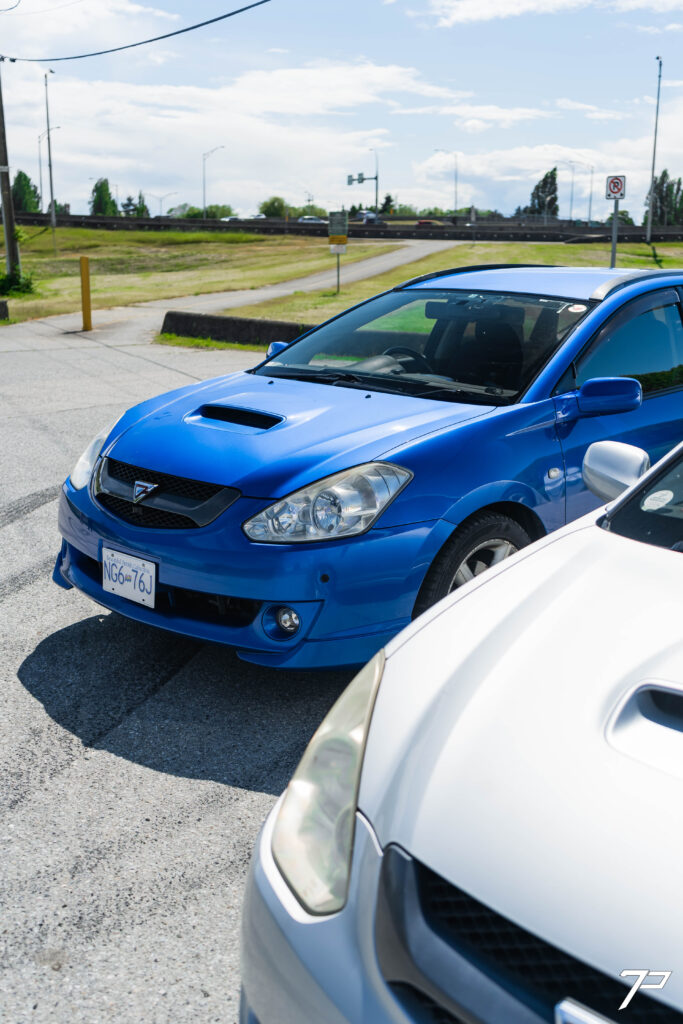An end of an era. It may open a chapter for new beginnings and further improvement for some. For Toyota, the GT-Four moniker meant a snarling turbocharged four-cylinder destined for rally stages was under the hood of the Celica. However, these streamlined wagons don’t look like any Celica we’ve ever seen. A Japanese market exclusive, meet the Caldina GT-Four. Thanks to our friends at Vancouver Velocity Cars and avid fan of Streetlight, Phil. We’ve had the pleasure of not one but two versions of this unparalleled JDM turbo wagon for our sampling pleasure. The silver car is a standard GT-Four currently available through Velocity, and Phil’s blue car is an extra special “N” model. The Caldina replaced the Corona and Carina wagons and has sister models known as the Allion and Premio (Avensis in Europe.)

Before we dive further into this compact wagon, we felt an introduction to the man behind the “N” initial. Known as the “Meister,” Hiromu Naruse was the chief test driver and test engineer for both Toyota Motor Corporation and Gazoo Racing Team. Naruse joined Toyota Motor Corporation in 1963 as a certified auto mechanic and was initially assigned to the company’s Vehicle Evaluation and Engineering Division as a temporary employee. Naruse quickly moved up the ladder, working on every performance-oriented Toyota. Hiromu involved his hands in several models, including the Sports 800, Corona 1600GT and 2000GT supercar. After being promoted to the chief mechanic of the corporation, Naruse would spearhead the deadly Toyota 7 prototypes in all of their forms and later lead to Naruse helping form Toyota Motorsports based out of Cologne in Germany. Naruse and the Celica would become inseparable over the years, honing the chassis through endurance racing and WRC rallying. His involvement would extend to other exciting Toyota products such as the Supra and MR-2/S variants. The GT-Four moniker and Naruse go hand in hand from the decades of accolades the two have accrued, and it was only fitting for his name to be attached to the final iteration of a GT-Four production car.

The Caldina is built on Toyota’s MC Platform, which underpinned various of the company’s compact front-wheel drive offerings, ranging from the Prius to the RAV-4. Visually, the Caldina looks closely related to the USDM market Corolla/Matrix/Pontiac Vibe, and that’s because it is. Many components are shared throughout the platform to help keep production variety cost-effective. Striking visuals complement Toyota’s millennium image. N models are further adorned with a unique aero treatment for added aggression. The interior is inviting and remarkably roomy for its compact size. It includes several standard features not found until recently in many cars, such as blind spot monitoring, front and rear cameras, and a touchscreen center display. In addition, n models received Recaro Trend front seats with matching fabric covering the rear bench and door panels.


Powering the Caldina is a special engine, the final generation of the now legendary 3S-GTE. A 2.0-litre iron block four-cylinder with a dual overhead camshaft aluminum cylinder head. As many of you know, the 3S was available in SW20 MR-2 and a few generations of the Celica with the GT-Four or All-Trac nameplate. This final and ultimately the most potent version of the engine is now equipped with coil-on-plug ignition, an air-to-air intercooler, and a turbocharger featuring an integrated exhaust manifold. With static compression up to 9.0:1 and 13psi (0.90 BAR) of boost, this 3S produced 256hp and 239lb/ft of torque. All of that power gets to pavement/gravel/dirt through all four wheels compliments of a four-speed automatic (unfortunately, it was the only option that could handle the torque output and retain four-wheel power transfer) transaxle with viscous coupling to the rear differential, which also housed a Torsen limited-slip if equipped with the “N” package like Phil’s car. Performance figures are sparse; however, the GT-Four is capable of 0-100km/h (62mph) in 6.4 seconds, and top speed is electronically-limited to 180km/h (112mph) under the Gentleman’s Agreement.

Though the Caldina has slightly mundane origins to form the basis for a performance car (the same could be said for the Impreza STI and Lancer Evolution), its suspension has been reworked to accommodate any driver’s sporting intentions along back roads. The front consists of Macpherson struts, with the rear using a multi-link to work around the differential. “N” package cars receive further special treatment with stiffer KYB struts and shocks, complimented by tighter wound springs. A unique “sprung” strut tower bar bridged the front suspension together. A coil spring is inserted at the mid-length of this bar, and on undulating surfaces such as those found on local back roads, the bar syncs and stiffens the top mounts. Braking is handled by vented discs and sliding calipers all around, with ABS and traction control being standard features (the N package receives more performance-oriented settings).

The Caldina marked the end of the GT-Four nameplate, making way for Gazoo Racing’s “GR” branded performance models such as the internationally available Yaris GR and upcoming Corolla GR filling in what the Caldina was, a bonafide turbo wagon for the masses.

